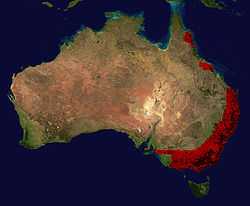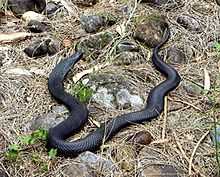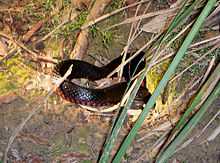Red-bellied black snake
| Red-bellied black snake | |
|---|---|
 | |
| Red-bellied black snake at Brisbane Forest Park, Brisbane, Queensland, Australia | |
| Scientific classification | |
| Kingdom: | Animalia |
| Phylum: | Chordata |
| Class: | Reptilia |
| Order: | Squamata |
| Suborder: | Serpentes |
| Family: | Elapidae |
| Genus: | Pseudechis |
| Species: | P. porphyriacus |
| Binomial name | |
| Pseudechis porphyriacus Shaw, 1794 | |
 | |
| Range of red-bellied black snake (in red) | |
The red-bellied black snake (Pseudechis porphyriacus) is a species of elapid snake native to eastern Australia. Though its venom is capable of causing significant morbidity, a bite from it is not generally fatal and is less venomous than other deadly Australian snakes. It is common in woodlands, forests and swamplands of eastern Australia. It is one of Australia's best-known snakes, as it is common in urban areas along the eastern coast of Australia. It has an average total length of 1.5 to 2 metres.[1]
Taxonomy
The species was first described by George Shaw in Zoology of New Holland (1794), placing it in the genus Coluber.[2] He believed the snake to be harmless to people.[3] The accompanying illustration was attributed to James Sowerby, but is regarded as being produced from drawings by John White.[4] The genus Pseudechis was created for it, though several subsequent species have been added. Snake expert Eric Worrell analyzed the skulls of the genus and found that of the red-bellied black snake to be the most divergent.[5]
Description
The red-bellied black snake is glossy black on the dorsal surface and red, crimson or pink in colour on the lower sides and belly. The snout is often a lighter brown colour. It is a relatively large species of snake reaching up to two metres in length,[6] with an extreme example measuring 2.5m, although an average sized specimen would be closer to 1.4 m. Like all Elapid snakes it is front fanged. It has 17 mid-body scale rows. Juveniles are similar to the eastern small-eyed snake, with which it can be easily confused.[7]
Distribution and habitat
The red-bellied black snake is native to the east coast of Australia. It can be found in the urban forest, woodland, plains and bushland areas of the Blue Mountains, Canberra, Sydney, Brisbane, Melbourne, Cairns and Adelaide. It is most commonly seen close to dams, streams, billabongs and other bodies of water.[1]
Nature
This is generally not an aggressive species. However, when provoked, it will recoil into its striking stance as a threat, but will try to escape at the first opportunity.[8] It is most active by day. When not hunting or basking it may be found beneath timber, rocks and rubbish or down holes and burrows.
Diet

The diet of red-bellied black snake primarily consists of frogs, but it also preys on reptiles and small mammals. They also eat other snakes, including those of their own species.
Venom
The venom of red-bellied black snake consists of neurotoxins, myotoxins, coagulants and also has haemolytic properties. Bites from red-bellied black snake are rarely life-threatening due to the snake usually choosing to inject little venom toxin, but are still in need of immediate medical attention. Tiger snake antivenom is used to treat bites.[9] While black snake antivenom can be used, tiger snake antivenom can be used at a lower dose. The smaller dose is cheaper to produce, and is less likely to cause a reaction in the patient.[10]
Reproduction
Red-bellied black snakes are ovoviviparous; that is, they give birth to live young in individual membranous sacs.[1] The young, numbering between eight and forty, emerge from their sacs very shortly after birth, and have an average length of about 122mm.[11] In the wild, few will survive to reproduce.
Gallery
-

Red-bellied black snake at Brisbane Forest Park, Brisbane, Queensland, Australia
-

Red-bellied black snake in zoo enclosure
-

Red-bellied black snake basking in the sun
-
Red-bellied black snake at Lake Eacham, Atherton Tableland, Queensland, Australia
-

Red-bellied black snake at Brisbane Forest Park, Brisbane, Queensland, Australia
-
Red-bellied black snake at Brisbane Forest Park, Brisbane, Queensland, Australia
-

Red-bellied black snake eating the eggs of a green tree snake near Dungog, Australia
-
.jpg)
"Coluber porphyriacus", Zoology and botany of New Holland (1794)[1]
- ^ Tab. X of: Zoology and botany of New Holland and the isles adjacent / the zoological part by George Shaw, the botanical part by James Edward Smith; the figures by James Sowerby
References
- ↑ 1.0 1.1 1.2 Swan, Steven K. Wilson ; Gerry (2010). A complete guide to reptiles of Australia (3rd ed.). Chatswood, N.S.W.: New Holland Publishers. ISBN 978-1-877069-76-5.
- ↑ Pseudechis porphyriacus at the Reptarium.cz Reptile Database
- ↑ Williams, David; Wuster, Wolfgang; Fry, Bryan Grieg (2006). "The good, the bad and the ugly: Australian snake taxonomists and a history of the taxonomy of Australia's venomous snakes". Toxicon 48 (7): 919–30. doi:10.1016/j.toxicon.2006.07.016. PMID 16999982.
- ↑ Picture Library State Library of Victoria
- ↑ Worrell, Eric (1961). "Herpetological Name Changes". West Australian Naturalist 8: 18–27.
- ↑ Australian Broadcasting Corporation. "Massive red-bellied black snake surprises Newcastle wrangler called in to remove it". Retrieved 2014-10-02.
- ↑ Reptile Park. "Red Bellied Black Snake". Retrieved 2007-12-28.
- ↑ Bain, Libby. "The Australian Reptile Park and Wildlife Sanctuary". Red-bellied Black Snake – Pseudechis porphyriacus. Australian Reptile Park. Retrieved 1 July 2011.
- ↑ Toxinology.com. "CSL Antivenom Handbook". Retrieved 2007-12-28.
- ↑ Mirtschin, Peter. "Relative Toxicity of Australian Snakes". Archived from the original on 2007-10-28. Retrieved 2007-12-28.
- ↑ Cogger, Harold G (1983) [1979]. Reptiles and Amphibians of Australia (Rev. ed.). Reed. p. 449. ISBN 0883590484.
External links
- Red-bellied Black Snake – Australian Museum
- Red-bellied Black Snake video
- Pictures of Red-bellied Black Snake's fangs
- Red-bellied Black Snake – Australian Venom Research Unit, Department of Pharmacology, the University of Melbourne
![]() Data related to Pseudechis porphyriacus at Wikispecies
Data related to Pseudechis porphyriacus at Wikispecies
![]() Media related to Pseudechis porphyriacus at Wikimedia Commons
Media related to Pseudechis porphyriacus at Wikimedia Commons

